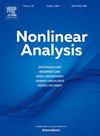H1 regularity of the minimizers for the inviscid total variation and Bingham fluid problems for H1 data
IF 1.3
2区 数学
Q1 MATHEMATICS
引用次数: 0
Abstract
The Bingham fluid model for viscoplastic materials involves the minimization of a nondifferentiable functional. The regularity of the associated solution is investigated here. The simplified scalar case is considered first: the total variation minimization problem. Our main result proves for a convex domain that a right-hand side gives a solution . Homogeneous Dirichlet conditions involve an additional trace term, then implies . In the case of the inviscid vector Bingham fluid model, boundary conditions are difficult to handle, but we prove the local regularity of the solution for . The proofs rely on several generalizations of a lemma due to Brézis and on the viscous approximation. We obtain Euler–Lagrange characterizations of the solution. Homogeneous Dirichlet conditions on the viscous problem lead in the vanishing viscosity limit to relaxed boundary conditions of frictional type.
无粘总变分的最小值的H1规则性和H1数据的Bingham流体问题
粘塑性材料的Bingham流体模型涉及到一个不可微泛函的最小化。本文研究了关联解的规律性。首先考虑简化的标量情况:总变差最小化问题。我们的主要结果证明了对于一个凸域Ω,右边的f∈H1(Ω)给出了一个解u∈H1(Ω)。齐次狄利克雷条件包含一个附加的迹项,则f∈H01(Ω)意味着u∈H01(Ω)。对于无粘矢量Bingham流体模型,边界条件难以处理,但我们证明了f∈Hloc1(Ω)n解的局部Hloc1(Ω)n的正则性。这些证明依赖于一个引理的几个推广和粘滞近似。我们得到了解的欧拉-拉格朗日表征。黏性问题的齐次狄利克雷条件导致黏性极限消失为摩擦型松弛边界条件。
本文章由计算机程序翻译,如有差异,请以英文原文为准。
求助全文
约1分钟内获得全文
求助全文
来源期刊
CiteScore
3.30
自引率
0.00%
发文量
265
审稿时长
60 days
期刊介绍:
Nonlinear Analysis focuses on papers that address significant problems in Nonlinear Analysis that have a sustainable and important impact on the development of new directions in the theory as well as potential applications. Review articles on important topics in Nonlinear Analysis are welcome as well. In particular, only papers within the areas of specialization of the Editorial Board Members will be considered. Authors are encouraged to check the areas of expertise of the Editorial Board in order to decide whether or not their papers are appropriate for this journal. The journal aims to apply very high standards in accepting papers for publication.

 求助内容:
求助内容: 应助结果提醒方式:
应助结果提醒方式:


